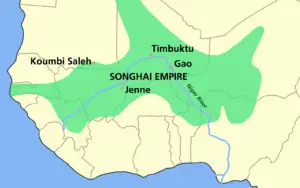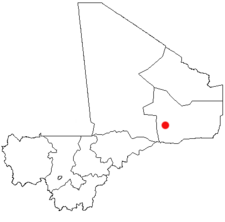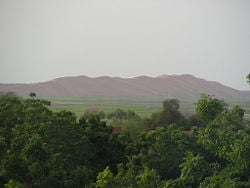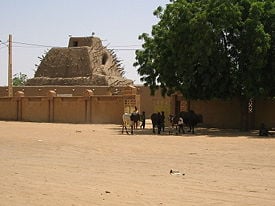Difference between revisions of "Tomb of Askia" - New World Encyclopedia
Vicki Phelps (talk | contribs) |
Rosie Tanabe (talk | contribs) m |
||
| (44 intermediate revisions by 3 users not shown) | |||
| Line 1: | Line 1: | ||
| − | {{Images OK}} | + | {{Images OK}}{{Submitted}}{{Approved}}{{Copyedited}} |
{{Infobox World Heritage Site | {{Infobox World Heritage Site | ||
| WHS = Tomb of Askia | | WHS = Tomb of Askia | ||
| Line 12: | Line 12: | ||
| Link = http://whc.unesco.org/en/list/1139 | | Link = http://whc.unesco.org/en/list/1139 | ||
}} | }} | ||
| + | The '''Tomb of Askia''', in Gao, [[Mali]], is the burial place of [[Askia Mohammad I]], also known as Askia the Great, for his expansion of the [[Songhai Empire]]. A [[UNESCO]] [[World Heritage Site]], it was built at the end of the fifteenth century after Askia Mohamed had returned from [[Mecca]] and made [[Islam]] the official [[religion]] of the empire. It remains the largest historic [[architecture|architectural]] monument in [[West Africa]]. Askia is in regular use as a mosque and a publicly owned cultural center for the city of Gao. The site and a buffer area around it are protected by both national and local laws. | ||
| − | The | + | UNESCO describes the Askia site as a "fine example of the monumental mud-building traditions of the West African Sahel." The complex includes the [[pyramid]]al tomb, two [[mosque]]s, a [[cemetery]] dating from the time of Askia, with many inscribed stone stelae, and an open-air assembly ground. At 17 meters in height it is the largest pre-[[Colonialism|colonial]] [[architecture|architectural]] monument in the region. It is the first example of an [[Islam]]ic architectural style that later spread throughout the region. Such structures, made only of earth mixed with water, display a remarkable diversity of form. |
| + | {{toc}} | ||
| + | The [[Songhai Empire]] flourished in the fifteenth and sixteenth centuries through its control of the trans-[[Sahara]]n trade, primarily in [[salt]] and [[gold]]. The complex, of which the tomb is the central structure, bears testimony to that empire. Its [[architecture]] reflects the integration of local building traditions of the [[West Africa]]n [[Sahel]] and the influences of [[North Africa]]. | ||
| − | + | == History == | |
| + | [[Image:SONGHAI empire map.PNG|thumb|right|300px|The Songhai Empire, c. 1500]] | ||
| + | [[Image:ML-Gao.png|thumb|right|225px|The location of Gao in Mali]] | ||
| − | + | [[Askia Mohammad I]] (also known as Muhammad Toure) was the first Askia emperor and greatly expanded the [[Songhai Empire]], which flourished in the fifteenth and sixteenth centuries through its control of trans-[[Sahara]]n [[trade]]. As a revert [[Muslim]] (convert to Islam), he felt obligated to make his pilgrimage to [[Mecca]], which he returned from in 1495 or 1496. During his pilgrimage, Askia Mohammad obtained the title "Caliph of the Sudan" (the area now known as [[West Africa]]) from the last Abbasid caliph, al-Mutawakkil, giving his regime a new Islamic legitimacy. He brought back with him the materials to make his tomb; all the mud and wood come from [[Mecca]]. The caravan is said to have consisted of "thousands of camels." The tomb was structured as a house, with several rooms and passageways, and was sealed when Mohammed died. Askia Mohommed is the only one buried inside the tomb itself, but several other Askias are buried in the courtyard. | |
| − | + | Mohammad's ties with the wider Islamic world were closer than those of previous monarchs in the region. He frequently consulted Islamic judges and scholars on how to best govern his empire. One of these scholars, Al-Maghili is credited with introducing [[Sufism]] to the area and spreading the idea of the Mujaddid or "Renewer of Islam" that would become an important theme in the history of the region. Another important Islamic scholar who influenced Askia Mohammad was Jalala AI-Din Al-Suyuti, an [[Egypt]]ian who advised Askia Mohammad on how to tailor [[Islamic law]] to fit the special needs of the [[Sahara]] and [[Sahel]]. Even though Askia Mohammad was a pious Muslim, he retained many traditional aspects of Songhai culture and did not try to convert non-Muslims through conquest. | |
| − | == | + | ===Trans-Saharan trade=== |
| + | Through much of its history, [[Gao]] was a center of trade and learning and served as capital of the [[Songhai Empire]]. It is similar to, and culturally connected with, the great trans-Saharan trade cities of [[Timbuktu]] and [[Djenne]]. The westernmost of the three central routes ran from the [[Niger River]] at Gao north to [[Tripoli]], [[Libya]]. | ||
| − | + | [[Mediterranean basin|Mediterranean]] economies were short of [[gold]] but could supply [[salt]], whereas [[West Africa]]n countries had plenty of gold but needed salt. The trans-Saharan [[slave trade]] was also important. Large numbers of [[Africa]]ns were sent north, generally to serve as domestic servants or slave concubines.<ref>''San Francisco Unified School District''. [http://www.sfusd.k12.ca.us/schwww/sch618/Ibn_Battuta/Battuta's_Trip_Twelve.html Ibn Battuta's Trip: Part Twelve - Journey to West Africa (1351 - 1353)] Retrieved February 2, 2009.</ref> The West African states imported highly trained slave soldiers. It has been estimated that from the 10th to the 19th century some 6,000 to 7,000 slaves were transported north each year.<ref>J.D. Fage and William Tordoff. 2001. ''A History of Africa''. (London: Routledge. 256 ISBN 9780415252485)</ref> Perhaps as many as nine million slaves were exported along the trans-Saharan caravan route.<ref>''Le Monde diplomatique''. April 1998. [http://mondediplo.com/1998/04/02africa The impact of the slave trade on Africa] Retrieved February 2, 2009.</ref> | |
| − | |||
| − | [ | ||
| − | |||
| − | |||
| − | |||
| − | |||
===Role of Gao=== | ===Role of Gao=== | ||
| − | The city of Gao was founded around the seventh century as ''Kawkaw'', its first recorded monarch being Kanda, who founded the Za Dynasty of what became the [[Songhai Empire]]. | + | [[Image:La_Dune_Rose.jpg|thumb|right|250px|La Dune Rose and Gao city as seen from the top of the Tomb of Askia]] |
| + | The city of Gao was founded around the seventh century as ''Kawkaw'', its first recorded monarch being Kanda, who founded the Za Dynasty of what became the [[Songhai Empire]]. He ensured the city’s growth by allowing trans-Saharan traders to visit and [[Berber]]s to settle. Trade increased after Za Kossoi converted to [[Islam]] in 1009. | ||
| − | The [[Mali Empire]] conquered Gao sometime before 1300, but Ali Golon re-established Songhai rule. A distinguished author of the period, Al-Idrissi, described it as a "populous, unwalled, commercial and industrial town, in which were to be found the produce of all arts and trades necessary for its inhabitants" | + | The [[Mali Empire]] conquered Gao sometime before 1300, but Ali Golon re-established Songhai rule. A distinguished author of the period, Al-Idrissi, described it as a "populous, unwalled, commercial and industrial town, in which were to be found the produce of all arts and trades necessary for its inhabitants." |
Mali was a Muslim kingdom, and under it, the [[gold]]-[[salt]] trade established in the pre-Roman era continued. Other trade goods were [[slave trade|slaves]], kola nuts from the south, and slave beads and cowrie shells from the north (for use as currency). It was under Mali that the great cities of the [[Niger River]] bend—including Gao—prospered. | Mali was a Muslim kingdom, and under it, the [[gold]]-[[salt]] trade established in the pre-Roman era continued. Other trade goods were [[slave trade|slaves]], kola nuts from the south, and slave beads and cowrie shells from the north (for use as currency). It was under Mali that the great cities of the [[Niger River]] bend—including Gao—prospered. | ||
| − | Askia Mohammed expanded his empire by conquest until it covered an area that stretched over 2,000 miles, from the mouth of the [[Gambia River]] in the west to [[Lake Chad]] in the east. In the process he established a strongly centralized administration, though in some cases he allowed regional kings to continue ruling as long as they paid tribute. | + | By the end of the 1460s Sonna Ali Ber, the founder of the Songhai Empire, had taken [[Djenne]] and [[Timbuktu]], thus gaining control of some of the principal trading towns of the [[Sahel]]. Ali was succeeded by [[Askia Mohammad I]], who defeated the heir in battle in 1493, then consolidated his territorial conquests and introduced Islam as the state religion. The empire flourished for the next hundred years until the [[Morocco|Moroccan]] conquest of 1591. |
| + | |||
| + | Askia Mohammed expanded his empire by conquest until it covered an area that stretched over 2,000 miles, from the mouth of the [[Gambia River]] in the west to [[Lake Chad]] in the east. In the process he established a strongly centralized administration, though in some cases he allowed regional kings to continue ruling as long as they paid tribute. He died in 1528. | ||
| − | During his rule, Gao had about 70,000 residents and a 1,000-boat [[navy]], but Gao was largely destroyed by the | + | During his rule, Gao had about 70,000 residents and a 1,000-boat [[navy]], but Gao was largely destroyed by the Moroccan invasion of 1591. The town remained small until [[France|French]] rule was imposed in the early twentieth century, when the [[port]] was expanded. It had a population of 57,978 in 2005.<ref name=pop>''Communiqué du Conseil des ministres''. January 3, 2007. </ref> |
| + | |||
| + | Other attractions in Gao include the original fourteenth-century Gao Mosque, a [[museum]] devoted to the [[Sahel]], [[market]]s including a night market, and La Dune Rose, a [[sand]] [[dune]] named for its appearance at dawn and nightfall. | ||
| + | |||
| + | Gao has an international [[airport]] and is linked to other cities along the [[Niger River]], including [[Timbuktu]], by a [[ferry]] service. In 2006 a new bridge across the Niger at Gao was inaugurated. While for centuries a transit and trade hub, the [[tourism|tourist]] industry, especially serving cruises of the Niger, has also become important to the local economy. | ||
| + | |||
| + | ==Architecture== | ||
| + | [[Image:Tombeau dAskia in Gao by David Sessoms.jpg|thumb|275px|The Tomb of Askia]] | ||
| + | Mud either as [[brick]] or as pisé is associated with the greatest examples of [[West Africa]]'s monumental [[architecture]]. The area most suited to mud-brick architecture is the [[savanna]], where there is enough water to make bricks, [[plaster]], and pisé (rammed earth) yet not too much [[rain]] to dissolve the dried mud walls. Traditionally, rammed earth buildings are common in arid regions where [[wood]] is in scarce supply. The traditional methods of mud architecture vary from one town to another; in Djenne cylindrical mud bricks were used, whereas in other towns simple dried-earth lumps were the building material. | ||
| + | |||
| + | Mud architecture lends itself to the creation of plastic sculptural forms on fairly simple structures, thus a simple rectangular facade can be enlivened by the addition of crenellations, engaged pillars, and decorative panels. | ||
| + | |||
| + | The Tomb of Askia is the central commanding feature of the [[Great Mosque of Gao]]. This layout pays homage to the Saharan tradition of prominent ancestral [[tumuli]] or tomb mounds erected over graves that date to before 1000 B.C.E. This large feature was incorporated into a new mosque building tradition in which the mosque itself becomes a combination of tomb, minaret, and sacred enclosure. | ||
| + | |||
| + | The tomb itself is built on an almost square plan measuring about 14 by 18 meters. The four faces are aligned according to the cardinal directions, as are the outer walls of the mosque. The earthen tomb rises from its base as a stepped pyramidal tower articulated by three distinct levels to a height of just over 10 meters. The earthen exterior walls taper inward upon ascent and are distinguished by many protruding ''toron'', or stakes, of [[acacia]] wood. Such stakes bristling from the walls provide a permanent scaffolding for replastering the mud that has washed away. When contrasted with other mosques displaying the more common straight and linear toron, such as at the Djenné Great Mosque, these stakes give the Tomb of Askia a wild appearance. The tomb is enclosed within the eight-foot wall of the larger mosque complex, the area of which is about 45 by 50 meters.<ref name=archnet>''Archnet''. [http://archnet.org/library/sites/one-site.jsp?site_id=2541 Askia Tomb] Retrieved January 27, 2009.</ref> | ||
| + | |||
| + | The tomb is a radical departure from the prior conical articulation of the popular Songhai earthen tumulus. Furthermore, surmising based on the numerology of its unique shape, Labelle Prussin claims that the mathematical articulation of the three-level, four-sided pyramid corresponded to "the traditional ancestors (who) were enveloped in the robes of Islam and magic squares." However, this style was probably borrowed from the square, three-stepped stairway minarets of the Ibadite zawiyas, or holy shrines, of the Mzab region of southern [[Algeria]], a cultural adaptation that is made understandable by the fact that Askia Mohammed hosted numerous Ibadi scholars. Further, it must be noted that a similar building evolution was happening contemporary to Askia's reign under the [[Fulani]] in the [[Hausa]] region of northern [[Nigeria]], such as with the Great Mosque of Kano.<ref name=archnet/> | ||
| + | |||
| + | ===Modifications=== | ||
| + | Relatively recent modifications to the site have included the expansion of the mosque buildings in the 1960s and mid-1970s, and the 1999 construction of a wall around the site. It has also been regularly replastered throughout its history, a process essential to the maintenance and repair of mud structures. [[Electricity]] was added in the early 2000s, allowing for ceiling fans, lights, and a loudspeaker mounted on top. On the east side is a winding external stair leading to the summit. | ||
==Notes== | ==Notes== | ||
| Line 46: | Line 68: | ||
==References== | ==References== | ||
| − | * ''African Holocaust''. [http://www.africanholocaust.net/africanlegends.htm#askia Askia The Great (1538)] Retrieved January 26, 2009. | + | * ''African Holocaust''. [http://www.africanholocaust.net/africanlegends.htm#askia Askia The Great (1538)] Retrieved January 26, 2009. |
* ''Black History Pages''. [http://www.blackhistorypages.net/pages/askia.php Askia Mohammed I (Askia the Great)] Retrieved January 26, 2009. | * ''Black History Pages''. [http://www.blackhistorypages.net/pages/askia.php Askia Mohammed I (Askia the Great)] Retrieved January 26, 2009. | ||
| − | * Sliwoski, Amelia Helena. 2007. | + | * Sliwoski, Amelia Helena. 2007. [http://proquest.umi.com/pqdweb?did=1467887251&sid=6&Fmt=2&clientId=39334&RQT=309&VName=PQD. ''Islamic ideology and ritual architectural and spatial manifestations''.] Thesis (M.A.)—State University of New York at Buffalo, 2007. {{OCLC|232266969}} |
* ''The American Forum for Global Education''. 2000. [http://www.globaled.org/nyworld/materials/african3.html Early African Empires and their Global Connections] Retrieved January 26, 2009. | * ''The American Forum for Global Education''. 2000. [http://www.globaled.org/nyworld/materials/african3.html Early African Empires and their Global Connections] Retrieved January 26, 2009. | ||
*''UNESCO World Heritage Centre.'' [http://whc.unesco.org/archive/advisory_body_evaluation/1139.pdf Advisory Body Evaluation, Tomb of Askia, Mali] Retrieved January 26, 2009. | *''UNESCO World Heritage Centre.'' [http://whc.unesco.org/archive/advisory_body_evaluation/1139.pdf Advisory Body Evaluation, Tomb of Askia, Mali] Retrieved January 26, 2009. | ||
| Line 57: | Line 79: | ||
[[Category:Geography]] | [[Category:Geography]] | ||
{{Credit|262051016}} | {{Credit|262051016}} | ||
| − | |||
Latest revision as of 23:53, 10 December 2015
| Tomb of Askia* | |
|---|---|
| UNESCO World Heritage Site | |
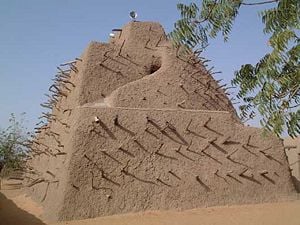
| |
| State Party | |
| Type | Cultural |
| Criteria | ii, iii, iv |
| Reference | 1139 |
| Region** | Africa |
| Inscription history | |
| Inscription | 2004 (28th Session) |
| * Name as inscribed on World Heritage List. ** Region as classified by UNESCO. | |
The Tomb of Askia, in Gao, Mali, is the burial place of Askia Mohammad I, also known as Askia the Great, for his expansion of the Songhai Empire. A UNESCO World Heritage Site, it was built at the end of the fifteenth century after Askia Mohamed had returned from Mecca and made Islam the official religion of the empire. It remains the largest historic architectural monument in West Africa. Askia is in regular use as a mosque and a publicly owned cultural center for the city of Gao. The site and a buffer area around it are protected by both national and local laws.
UNESCO describes the Askia site as a "fine example of the monumental mud-building traditions of the West African Sahel." The complex includes the pyramidal tomb, two mosques, a cemetery dating from the time of Askia, with many inscribed stone stelae, and an open-air assembly ground. At 17 meters in height it is the largest pre-colonial architectural monument in the region. It is the first example of an Islamic architectural style that later spread throughout the region. Such structures, made only of earth mixed with water, display a remarkable diversity of form.
The Songhai Empire flourished in the fifteenth and sixteenth centuries through its control of the trans-Saharan trade, primarily in salt and gold. The complex, of which the tomb is the central structure, bears testimony to that empire. Its architecture reflects the integration of local building traditions of the West African Sahel and the influences of North Africa.
History
Askia Mohammad I (also known as Muhammad Toure) was the first Askia emperor and greatly expanded the Songhai Empire, which flourished in the fifteenth and sixteenth centuries through its control of trans-Saharan trade. As a revert Muslim (convert to Islam), he felt obligated to make his pilgrimage to Mecca, which he returned from in 1495 or 1496. During his pilgrimage, Askia Mohammad obtained the title "Caliph of the Sudan" (the area now known as West Africa) from the last Abbasid caliph, al-Mutawakkil, giving his regime a new Islamic legitimacy. He brought back with him the materials to make his tomb; all the mud and wood come from Mecca. The caravan is said to have consisted of "thousands of camels." The tomb was structured as a house, with several rooms and passageways, and was sealed when Mohammed died. Askia Mohommed is the only one buried inside the tomb itself, but several other Askias are buried in the courtyard.
Mohammad's ties with the wider Islamic world were closer than those of previous monarchs in the region. He frequently consulted Islamic judges and scholars on how to best govern his empire. One of these scholars, Al-Maghili is credited with introducing Sufism to the area and spreading the idea of the Mujaddid or "Renewer of Islam" that would become an important theme in the history of the region. Another important Islamic scholar who influenced Askia Mohammad was Jalala AI-Din Al-Suyuti, an Egyptian who advised Askia Mohammad on how to tailor Islamic law to fit the special needs of the Sahara and Sahel. Even though Askia Mohammad was a pious Muslim, he retained many traditional aspects of Songhai culture and did not try to convert non-Muslims through conquest.
Trans-Saharan trade
Through much of its history, Gao was a center of trade and learning and served as capital of the Songhai Empire. It is similar to, and culturally connected with, the great trans-Saharan trade cities of Timbuktu and Djenne. The westernmost of the three central routes ran from the Niger River at Gao north to Tripoli, Libya.
Mediterranean economies were short of gold but could supply salt, whereas West African countries had plenty of gold but needed salt. The trans-Saharan slave trade was also important. Large numbers of Africans were sent north, generally to serve as domestic servants or slave concubines.[1] The West African states imported highly trained slave soldiers. It has been estimated that from the 10th to the 19th century some 6,000 to 7,000 slaves were transported north each year.[2] Perhaps as many as nine million slaves were exported along the trans-Saharan caravan route.[3]
Role of Gao
The city of Gao was founded around the seventh century as Kawkaw, its first recorded monarch being Kanda, who founded the Za Dynasty of what became the Songhai Empire. He ensured the city’s growth by allowing trans-Saharan traders to visit and Berbers to settle. Trade increased after Za Kossoi converted to Islam in 1009.
The Mali Empire conquered Gao sometime before 1300, but Ali Golon re-established Songhai rule. A distinguished author of the period, Al-Idrissi, described it as a "populous, unwalled, commercial and industrial town, in which were to be found the produce of all arts and trades necessary for its inhabitants."
Mali was a Muslim kingdom, and under it, the gold-salt trade established in the pre-Roman era continued. Other trade goods were slaves, kola nuts from the south, and slave beads and cowrie shells from the north (for use as currency). It was under Mali that the great cities of the Niger River bend—including Gao—prospered.
By the end of the 1460s Sonna Ali Ber, the founder of the Songhai Empire, had taken Djenne and Timbuktu, thus gaining control of some of the principal trading towns of the Sahel. Ali was succeeded by Askia Mohammad I, who defeated the heir in battle in 1493, then consolidated his territorial conquests and introduced Islam as the state religion. The empire flourished for the next hundred years until the Moroccan conquest of 1591.
Askia Mohammed expanded his empire by conquest until it covered an area that stretched over 2,000 miles, from the mouth of the Gambia River in the west to Lake Chad in the east. In the process he established a strongly centralized administration, though in some cases he allowed regional kings to continue ruling as long as they paid tribute. He died in 1528.
During his rule, Gao had about 70,000 residents and a 1,000-boat navy, but Gao was largely destroyed by the Moroccan invasion of 1591. The town remained small until French rule was imposed in the early twentieth century, when the port was expanded. It had a population of 57,978 in 2005.[4]
Other attractions in Gao include the original fourteenth-century Gao Mosque, a museum devoted to the Sahel, markets including a night market, and La Dune Rose, a sand dune named for its appearance at dawn and nightfall.
Gao has an international airport and is linked to other cities along the Niger River, including Timbuktu, by a ferry service. In 2006 a new bridge across the Niger at Gao was inaugurated. While for centuries a transit and trade hub, the tourist industry, especially serving cruises of the Niger, has also become important to the local economy.
Architecture
Mud either as brick or as pisé is associated with the greatest examples of West Africa's monumental architecture. The area most suited to mud-brick architecture is the savanna, where there is enough water to make bricks, plaster, and pisé (rammed earth) yet not too much rain to dissolve the dried mud walls. Traditionally, rammed earth buildings are common in arid regions where wood is in scarce supply. The traditional methods of mud architecture vary from one town to another; in Djenne cylindrical mud bricks were used, whereas in other towns simple dried-earth lumps were the building material.
Mud architecture lends itself to the creation of plastic sculptural forms on fairly simple structures, thus a simple rectangular facade can be enlivened by the addition of crenellations, engaged pillars, and decorative panels.
The Tomb of Askia is the central commanding feature of the Great Mosque of Gao. This layout pays homage to the Saharan tradition of prominent ancestral tumuli or tomb mounds erected over graves that date to before 1000 B.C.E. This large feature was incorporated into a new mosque building tradition in which the mosque itself becomes a combination of tomb, minaret, and sacred enclosure.
The tomb itself is built on an almost square plan measuring about 14 by 18 meters. The four faces are aligned according to the cardinal directions, as are the outer walls of the mosque. The earthen tomb rises from its base as a stepped pyramidal tower articulated by three distinct levels to a height of just over 10 meters. The earthen exterior walls taper inward upon ascent and are distinguished by many protruding toron, or stakes, of acacia wood. Such stakes bristling from the walls provide a permanent scaffolding for replastering the mud that has washed away. When contrasted with other mosques displaying the more common straight and linear toron, such as at the Djenné Great Mosque, these stakes give the Tomb of Askia a wild appearance. The tomb is enclosed within the eight-foot wall of the larger mosque complex, the area of which is about 45 by 50 meters.[5]
The tomb is a radical departure from the prior conical articulation of the popular Songhai earthen tumulus. Furthermore, surmising based on the numerology of its unique shape, Labelle Prussin claims that the mathematical articulation of the three-level, four-sided pyramid corresponded to "the traditional ancestors (who) were enveloped in the robes of Islam and magic squares." However, this style was probably borrowed from the square, three-stepped stairway minarets of the Ibadite zawiyas, or holy shrines, of the Mzab region of southern Algeria, a cultural adaptation that is made understandable by the fact that Askia Mohammed hosted numerous Ibadi scholars. Further, it must be noted that a similar building evolution was happening contemporary to Askia's reign under the Fulani in the Hausa region of northern Nigeria, such as with the Great Mosque of Kano.[5]
Modifications
Relatively recent modifications to the site have included the expansion of the mosque buildings in the 1960s and mid-1970s, and the 1999 construction of a wall around the site. It has also been regularly replastered throughout its history, a process essential to the maintenance and repair of mud structures. Electricity was added in the early 2000s, allowing for ceiling fans, lights, and a loudspeaker mounted on top. On the east side is a winding external stair leading to the summit.
Notes
- ↑ San Francisco Unified School District. Ibn Battuta's Trip: Part Twelve - Journey to West Africa (1351 - 1353) Retrieved February 2, 2009.
- ↑ J.D. Fage and William Tordoff. 2001. A History of Africa. (London: Routledge. 256 ISBN 9780415252485)
- ↑ Le Monde diplomatique. April 1998. The impact of the slave trade on Africa Retrieved February 2, 2009.
- ↑ Communiqué du Conseil des ministres. January 3, 2007.
- ↑ 5.0 5.1 Archnet. Askia Tomb Retrieved January 27, 2009.
ReferencesISBN links support NWE through referral fees
- African Holocaust. Askia The Great (1538) Retrieved January 26, 2009.
- Black History Pages. Askia Mohammed I (Askia the Great) Retrieved January 26, 2009.
- Sliwoski, Amelia Helena. 2007. Islamic ideology and ritual architectural and spatial manifestations. Thesis (M.A.)—State University of New York at Buffalo, 2007. OCLC 232266969
- The American Forum for Global Education. 2000. Early African Empires and their Global Connections Retrieved January 26, 2009.
- UNESCO World Heritage Centre. Advisory Body Evaluation, Tomb of Askia, Mali Retrieved January 26, 2009.
- UNESCO World Heritage Centre. Tomb of Askia Retrieved January 26, 2009.
Credits
New World Encyclopedia writers and editors rewrote and completed the Wikipedia article in accordance with New World Encyclopedia standards. This article abides by terms of the Creative Commons CC-by-sa 3.0 License (CC-by-sa), which may be used and disseminated with proper attribution. Credit is due under the terms of this license that can reference both the New World Encyclopedia contributors and the selfless volunteer contributors of the Wikimedia Foundation. To cite this article click here for a list of acceptable citing formats.The history of earlier contributions by wikipedians is accessible to researchers here:
The history of this article since it was imported to New World Encyclopedia:
Note: Some restrictions may apply to use of individual images which are separately licensed.
